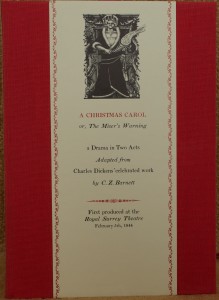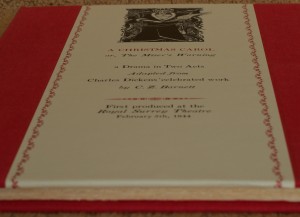For this year’s Christmas book, I finish up with the last of the three Christmas-themed books published by the Barbarian Press. It’s fitting that the last is also the first in many respects. It was the first Christmas book that the press printed, and the tenth book overall, when it was published in 1984. It was also the first time they were to publish a book with illustrations. According to Hoi Barbaroi: A Quarter Century at the Barbarian Press, “the most important result of working with engravings was JE’s discovery of her affinity for printing them.” Finally, it was also the first time that Crispin cast type for a Barbarian Press book. Jim Rimmer of the Pie Tree Press & Typefoundry taught him to cast type and he was hooked. They bought the Monotype Sorts Caster from Rimmer and were off and running down another of printing’s many fascinating twists and turns.
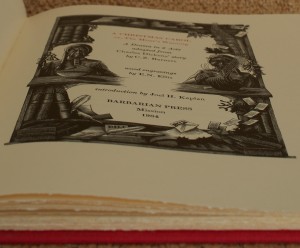 Joel H. Kaplan, “a Shakespeare scholar and devotee of 19th century theatre,” was instrumental in suggesting and making this book happen. He also wrote the very informative introduction to the edition. It is quite amazing how quickly Dickens’ books were adapted for the stage, in some cases before the author’s publisher even got the official book out, and complete with competing versions from rival playhouses and companies. Kaplan writes that by the time A Christmas Carol, Dickens had begun “actively assisting with stage representations of his works.” The stage adaptor Dickens turned to for the authorized version, Edward Stirling, is not the one we get the pleasure of meeting here. Rather, the press chose the
Joel H. Kaplan, “a Shakespeare scholar and devotee of 19th century theatre,” was instrumental in suggesting and making this book happen. He also wrote the very informative introduction to the edition. It is quite amazing how quickly Dickens’ books were adapted for the stage, in some cases before the author’s publisher even got the official book out, and complete with competing versions from rival playhouses and companies. Kaplan writes that by the time A Christmas Carol, Dickens had begun “actively assisting with stage representations of his works.” The stage adaptor Dickens turned to for the authorized version, Edward Stirling, is not the one we get the pleasure of meeting here. Rather, the press chose the 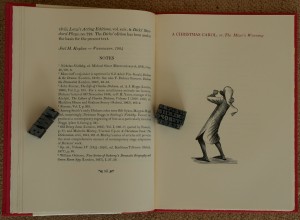 “distinctly unauthorized” melodramatic and farcical version by C. Z. Barnett. According to the Barbarian Press website, adapting to the dictates of the popular theatre of the time meant that
“distinctly unauthorized” melodramatic and farcical version by C. Z. Barnett. According to the Barbarian Press website, adapting to the dictates of the popular theatre of the time meant that
Bob Cratchit becomes a wise-cracking clown; Fred, Scrooge’s nephew, loses his wealth in a shipwreck, but keeps a seasonably upper lip so as not to disturb his guests; Cratchit is mugged on his way home by a completely new character, Dark Sam, and financially reprieved by nephew Fred; and Tiny Tim – now, next to Scrooge, the symbol of the story – is relegated to a very minor position, and the famous ‘God bless us every one!’ doesn’t even make an appearance.
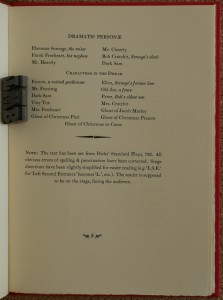 I definitely like the new Crachit and his cutting up around the well-known story line. He’s still poor enough for Scrooge to get in a pun at his expense even while marveling that he can still be happy and blessed. At the beginning of Act Two where Scrooge visits with the Spirit of Christmas Present, he remarks
I definitely like the new Crachit and his cutting up around the well-known story line. He’s still poor enough for Scrooge to get in a pun at his expense even while marveling that he can still be happy and blessed. At the beginning of Act Two where Scrooge visits with the Spirit of Christmas Present, he remarks
“Bob has fifteen bob a week. He pockets on Saturdays but fifteen copies of his Christian name, and yet the Ghost of Christmas Present blessed his four-roomed house.”
It’s really interesting to have so many perspectives on a piece of literature by an author who has become part of the world literature canon. We have the book itself as Dickens published it, we have the early stage adaptations, and we have the numerous modern theatre, opera, television, and other media adaptations. The story takes on a life of it’s own, effects how Christmas is 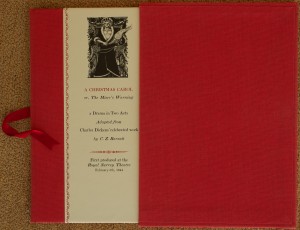 observed and our charitable giving, and has contributed common phrases like “Merry Christmas” and “Bah! Humbug” to the popular vernacular. Indeed, sometimes you have to go back to the original source to reset your perception of the novella itself, and that’s where I’m headed next.
observed and our charitable giving, and has contributed common phrases like “Merry Christmas” and “Bah! Humbug” to the popular vernacular. Indeed, sometimes you have to go back to the original source to reset your perception of the novella itself, and that’s where I’m headed next.
The book itself is beautiful to hold and to behold. I especially like the paper title label on the front cover that runs from top to bottom and whose creaminess creates a pleasing contrast to the red cloth binding, particularly with the addition of the red border printed along both sides of the label. The book is slip-cased in a matching cloth-covered case. Alas, it is without a spine label (a pet peeve of mine) but they make up for it by providing a ribbon that makes removing the book much easier and is elegant to boot.
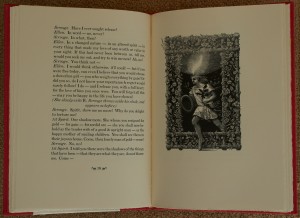 The illustrations were done by Edwina Ellis, who went on to being an internationally known printmaker. The Rasmussen Bindery in North Vancouver did the binding. And the Barbarian press settled into a synergy that has seen so many beautiful and award-winning books come our way: Jan doing the printing and Crispin designing the books and setting the type.
The illustrations were done by Edwina Ellis, who went on to being an internationally known printmaker. The Rasmussen Bindery in North Vancouver did the binding. And the Barbarian press settled into a synergy that has seen so many beautiful and award-winning books come our way: Jan doing the printing and Crispin designing the books and setting the type.
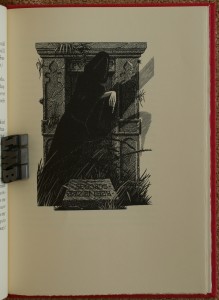 When I spoke to Crispin about A Christmas Carol, he seemed a little bit self-conscious of this book, being that it was a product of such an early stage of the press’ road to mastery. But to my eye, it’s a marvelous expression of holiday cheer and publishing. I certainly don’t see a first-timer in the printing of the illustrations by Jan, and the design of the book is simple and elegant. It’s too bad the market did not allow the press to complete their plans to publish all of Dickens’ Christmas books.
When I spoke to Crispin about A Christmas Carol, he seemed a little bit self-conscious of this book, being that it was a product of such an early stage of the press’ road to mastery. But to my eye, it’s a marvelous expression of holiday cheer and publishing. I certainly don’t see a first-timer in the printing of the illustrations by Jan, and the design of the book is simple and elegant. It’s too bad the market did not allow the press to complete their plans to publish all of Dickens’ Christmas books.
Merry Christmas and Happy Holidays to all. Thank you for your interest in and support for The Whole Book Experience. Have a peaceful and joyful 2014.
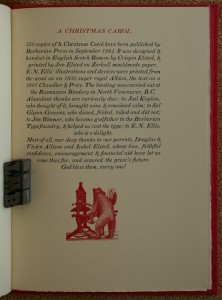 AVAILABILITY: Originally published in an edition of 350 copies, the book is no longer available through the press but occasionally can be found on the used- and fine-book market.
AVAILABILITY: Originally published in an edition of 350 copies, the book is no longer available through the press but occasionally can be found on the used- and fine-book market.
NOTE: The Whole Book Experience would like to thank Jan and Crispin of the Barbarian Press for the generosity that made this review possible.

